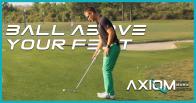Video Menu
My Favorite Videos
My Favorite Videos
Sidehill Lies - Ball Above Your Feet
Sorry, you need to be a member to access this video.
You Are Just Seconds Away - Become a member here!
Already a member? Log in now

Side Hill Lies are tough! Our new series of specialty shot videos, shows you golfers at home simple and effective ways to attack and manage these shots on the course. In this new video, I'll show you a quick and easy way to handle a ball above your feet situation on the course. I'll show you 2 quick and easy setup adjustments guaranteed to get you on the green and closer to the hole on these tough sidehill lies!
- Stabilize the lower body with the weight underneath the ankles and rolled in just slightly.
- Grip down on the club a bit to compensate for the slope
- Plan for the ball to hook due to the lie angle and a more shallow swing.
Okay guys, so in this next video of the Uneven Lies series, we're going to be facing a ball above our feet situation here.
And just like the other videos that we started putting out in the Uneven Lies, We're going to develop a simple checklist of things to look for in the golf course that are going to help you manage these things with ease.
So this shot can actually be pretty easy as far as a checklist is concerned.
First point of the checklist is going to be lower body stability.
We want to make sure that we set up with our weight right underneath our ankles.
We want to roll our ankles in just slightly.
That'll help get some contraction up in those upper part of the thighs, and that'll allow you to feel like you're put to the ground.
Really important because remember, when we start our downward move here, We're going to have a lot of inertia pulling us in the opposite direction here because gravity is starting to pull our mass down that hill.
So you want to set up with your weight right underneath your ankles, roll the ankles in slightly.
And what we're going to do to compensate for the slope here is we're going to choke down on the club a little bit.
So I've got a pretty good hanging lie here, okay, where it's probably about three to four inches above my feet.
So what I'm going to do is just choke down on the club, maybe three inches or so.
I'm going to keep everything else exactly the same.
Ball position, everything else in your setup is going to stay exactly the same.
So all we're looking for here is just to choke up on the golf club and lower body stability.
Now with hanging lies or ball above your feet, we have to have some compensations for what the ball is going to do.
Now those things, The tendency is, because of the lie angle, is that we're going to be swinging on a much more shallow angle, and when I talk about shallow, the club's going to be coming more from the inside, okay.
When the club comes more from the inside, that can tend to make the ball curve or hook.
So we're going to have to make up for that.
So we're going to have to align ourselves.
If I was lining up right at you guys, I'm going to have to shift myself a little bit, maybe five to ten yards right of my target, depending on the severity of the slope.
And this is something that you guys are going to have to play with at home.
You're going to have to understand how much your ball is going to curve off of certain situations.
So again, what we have is lower body stability, okay.
I'm going to choke up on the golf club here, and I'm going to aim, maybe in this shot I'm going to aim about eight yards right, and because, remember, I'm going to be swinging on a much more shallow angle of attack, if you tend to hit the ball higher, you're going to have to add another club to this, okay.
Because of the fact that on a shallow angle of attack here, the ball will tend to go even higher and then you're going to have to maybe grab an extra club.
So for today, I've got about a 180 yard shot here.
Normally I would hit probably a big eight iron, but now I've gone down to seven to kind of compensate for that.
So again, just a quick checklist for you.
I'm going to get my lower body really stable, weight underneath the ankles, roll the ankles in just slightly.
I'm going to choke down on the club to compensate just for the slope.
I've lined up about eight yards to the right, grabbed a little extra club here, and I'm going to go ahead and execute.



































































































































































































































































































































































































































































































Guy
Craig (Certified RST Instructor)
Bernard
Chris (Certified RST Instructor)
Bernard
Chris (Certified RST Instructor)
gordon
Craig (Certified RST Instructor)
gordon
Craig (Certified RST Instructor)
gordon
gordon
Krishna
Chris (Certified RST Instructor)
Cullen
Craig (Certified RST Instructor)
Robert James
Craig (Certified RST Instructor)
David
Craig (Certified RST Instructor)
John
Craig (Certified RST Instructor)
Jeff
Craig (Certified RST Instructor)
Franklin
Craig (Certified RST Instructor)
Chris
Chris (Certified RST Instructor)
Franklin
mike
john
R.J. (Certified RST Instructor)
R.J. (Certified RST Instructor)
john
R.J. (Certified RST Instructor)
john
R.J. (Certified RST Instructor)
john
R.J. (Certified RST Instructor)
Craig (Certified RST Instructor)
Andrew
Craig (Certified RST Instructor)
Andrew
Arnie
Craig (Certified RST Instructor)
Thomas
Chris (Certified RST Instructor)
Marcus
Chris (Certified RST Instructor)